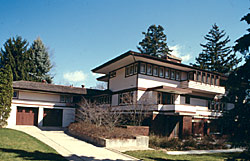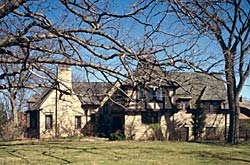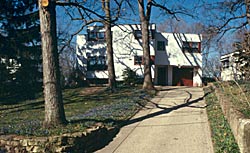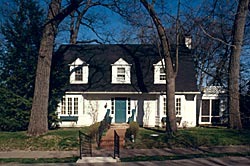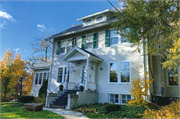Roughly bounded by University Bay, Harvard and Amherst drives and the corporate limit of Shorewood Hills
| Historic Name: | College Hills Historic District |
|---|---|
| Reference Number: | 02001518 |
| Location (Address): | Roughly bounded by University Bay, Harvard and Amherst drives and the corporate limit of Shorewood Hills |
|---|---|
| County: | Dane |
| City/Village: | Shorewood Hills |
| Township: |
| College Hills Historic District Village of Shorewood Hills, Dane County Dates of construction of contributing buildings: 1914-1959 As the population of downtown Madison grew, a new generation of real estate developers emerged. In 1913 John C. McKenna formed the University Bay Land Co. and purchased a portion of farmland to plat residential lots. The land was an ideal site with unspoiled views of Lake Mendota, Picnic Point and the University of Wisconsin campus in the distance. McKenna hoped the expanding university population would create a market so he named the plat "College Hills" and the streets after American or English colleges. In order to appeal to a well-educated elite, McKenna put out advertisements such as "A Neighborhood of High Class Homes" and "The Plat that Appeals to Good Judgment and Sentiment." Restrictions were set to enforce this idea. Initial sales were slow but by the end of World War I the need for more housing increased activity. McKenna purchased another strip of land and called the new plat Shorewood. Soon after the Village of Shorewood Hills, incorporating both College Hills and Shorewood, became a self-governing suburb of the City of Madison. Although a number of homes were built between the wars, it was not until after the Second World War that the majority of houses were built. The architectural unity of College Hills is its most attractive feature. Many of the houses were designed by prominent Madison and regionally notable architects. The earliest houses were fashioned in Progressive Styles such as Prairie School, Arts & Crafts and American Craftsman. Period Revival Styles were dominant between the wars but post World War II, styles shifted to a more contemporary design. College Hills boasts the largest concentration of Modern residential design in the Madison area. The homes in this neighborhood are private residences. Please respect the privacy of the owners.
|
| Period of Significance: | 1914-1959 |
|---|---|
| Area of Significance: | Architecture |
| Applicable Criteria: | Architecture/Engineering |
| Historic Use: | Domestic: Single Dwelling |
| Architectural Style: | International Style |
| Architectural Style: | Tudor Revival |
| Architectural Style: | Prairie School |
| Architectural Style: | Colonial Revival |
| Resource Type: | District |
| Architect: | Purcell and Elmslie |
| Architect: | Beatty and Strang |
| Historic Status: | Listed in the National Register |
|---|---|
| Historic Status: | Listed in the State Register |
| National Register Listing Date: | 12/09/2002 |
| State Register Listing Date: | 07/19/2002 |
| Number of Contributing Buildings: | 114 |
|---|---|
| Number of Contributing Sites: | 0 |
| Number of Contributing Structures: | 0 |
| Number of Contributing Objects: | 0 |
| Number of Non-Contributing Sites: | 0 |
| Number of Non-Contributing Structures: | 0 |
| Number of Non-Contributing Objects: | 0 |
| National Register and State Register of Historic Places, State Historic Preservation Office, Wisconsin Historical Society, Madison, Wisconsin |

